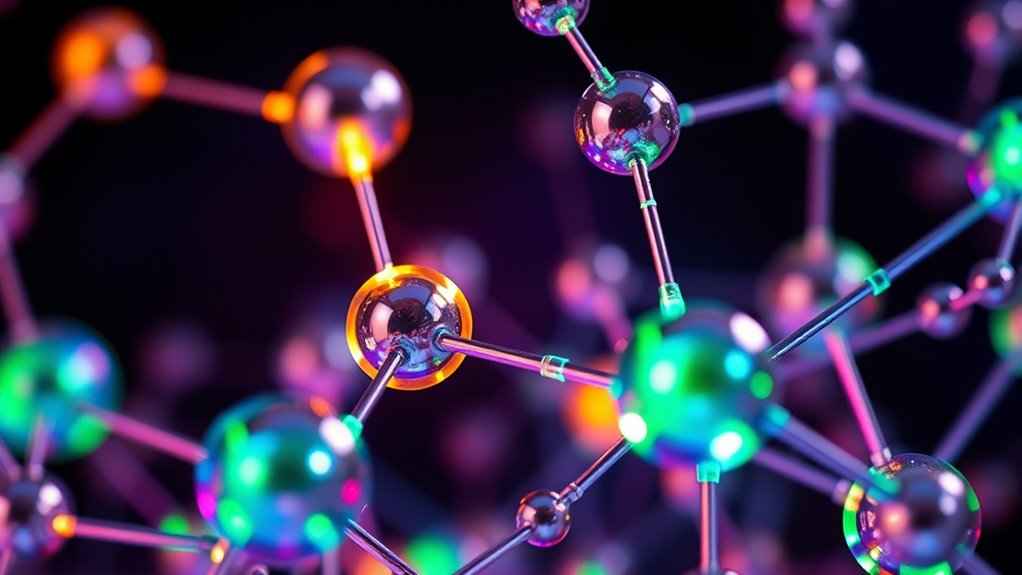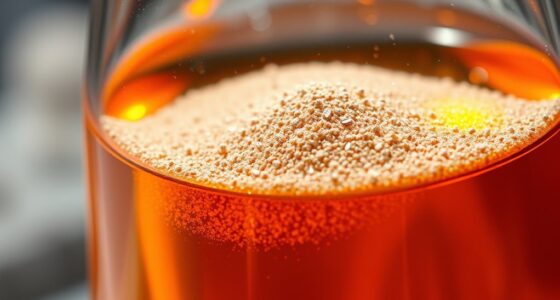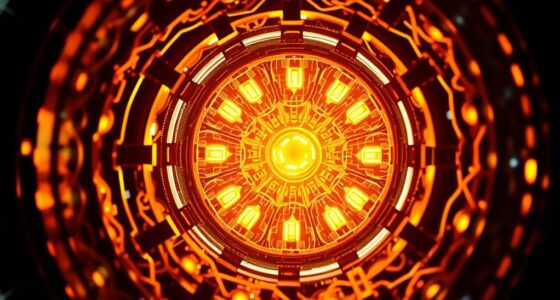Chemical bonds are how atoms stick together, shaping everything around you. Ionic bonds transfer electrons, forming charged ions that attract each other, creating stable structures like salt. Covalent bonds share electrons, building molecules with different properties, from water to plastics. Metallic bonds involve free electrons that let metals conduct electricity and bend without breaking. Exploring these bonds further reveals how they influence materials and biological systems, offering a deeper understanding of the world’s building blocks.
Key Takeaways
- Ionic bonds result from electron transfer between metals and non-metals, forming charged ions with strong electrostatic attraction.
- Covalent bonds involve sharing electron pairs between atoms, creating molecules with sigma and pi bond types.
- Metallic bonds feature delocalized electrons forming a “sea of electrons,” which give metals their conductivity and malleability.
- Bond polarity depends on electronegativity differences, influencing material properties like solubility, reactivity, and melting points.
- Non-covalent interactions, such as hydrogen bonds and van der Waals forces, play crucial roles in biological systems and material behaviors.
The Basics of Ionic Bonding
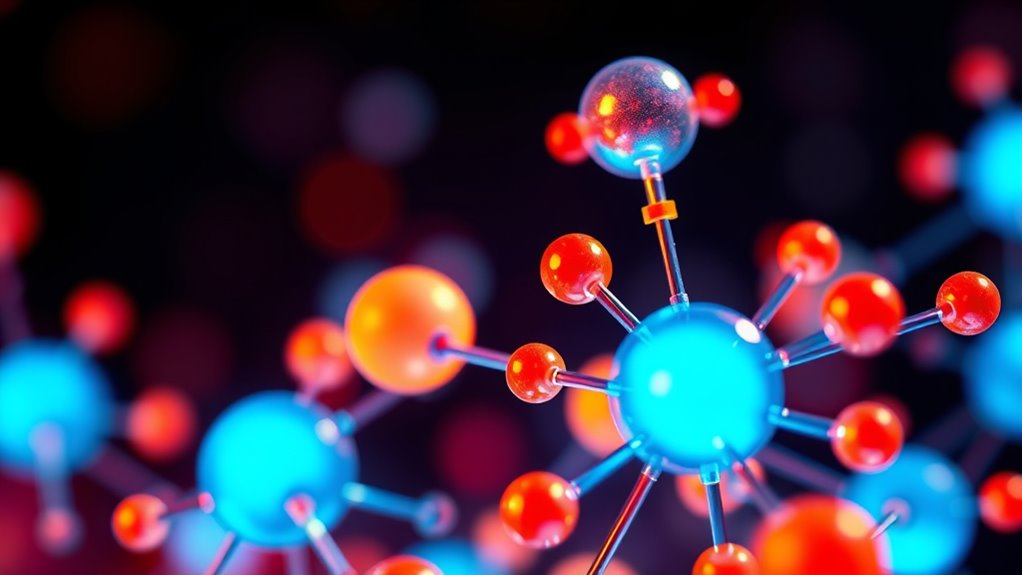
Have you ever wondered how certain compounds stay together so strongly? It all comes down to ionic bonding, which involves a complete transfer of valence electrons from one atom to another. This creates charged ions: metals lose electrons to become positively charged cations, while non-metals gain electrons to become negatively charged anions. Ionic bonds result from the electrostatic attraction between these oppositely charged ions, leading to a stable structure. These oppositely charged ions are held together by strong electrostatic forces, forming an organized lattice structure. Because of this, ionic compounds tend to have high melting and boiling points, and they often dissolve in water, conducting electricity when melted or dissolved. The strength of the bond depends on the charges and sizes of the ions involved. Ionic bonding is a fundamental way atoms combine, leading to stable, solid structures with unique properties. Additionally, the beneficial ingredients in eye patches, such as collagen and hyaluronic acid, can help improve skin hydration and elasticity, similar to how ionic bonds provide stability to compounds.
Understanding Covalent Bonds and Molecular Structures
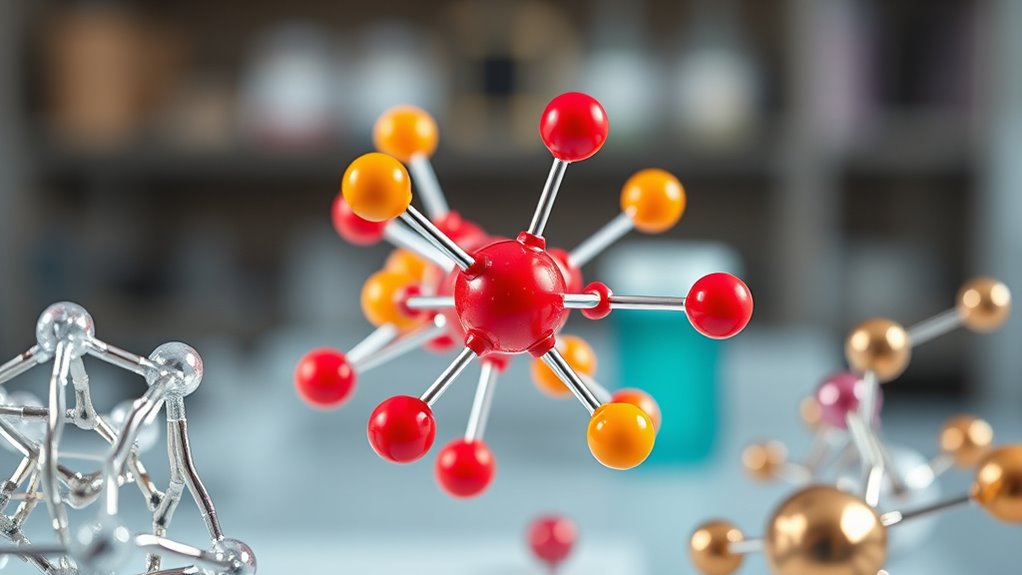
Covalent bonds form when atoms share electron pairs to achieve stable electron configurations. This sharing creates a balance between attractive and repulsive forces, stabilizing the molecule. It allows atoms to fill their valence shells, often between atoms with similar electronegativities, but not necessarily identical elements. The sharing of electrons can be described by quantum mechanical models that explain how orbitals overlap and form stable bonds. Bonding electrons can be localized between two atoms or delocalized across multiple atoms, affecting the molecule’s properties. Covalent bonding includes sigma (σ) bonds from head-on overlap and pi (π) bonds from sideways overlap. Single, double, and triple bonds involve one, two, or three shared pairs, increasing bond strength. Nonbonding electron pairs influence shape and reactivity, as seen with molecules like water and methane. These bonds form the foundation of complex molecules crucial to life and chemistry, and understanding electron sharing is essential for grasping molecular interactions.
Exploring Metallic Bonding and Its Unique Properties

Metallic bonding is a unique type of chemical bonding where valence electrons are delocalized and shared collectively among a lattice of metal ions. Instead of being localized between specific atoms, these electrons move freely throughout the crystal, forming a “sea” of electrons. This non-directional bond holds positively charged metal ions together through electrostatic attraction, creating a rigid, closely packed lattice with overlapping electron shells. The communal nature of metallic bonds gives metals their high electrical and thermal conductivity, as free electrons carry charge and vibrational energy efficiently. It also explains their malleability and ductility, since atoms can slide past each other without breaking the bond. Additionally, metals’ shiny appearance results from free electrons absorbing and re-emitting light across a broad spectrum. Understanding the credit card infrastructure and security measures can help protect against cyber threats that target payment data in the digital age.
The Concept of Electronegativity and Bond Polarity

Electronegativity is a key concept in chemistry that describes an atom’s ability to attract shared electrons within a chemical bond. It depends on nuclear charge and electron shielding, with elements like fluorine having the highest value of 4.0 on the Pauling scale. High electronegativity, seen in oxygen and nitrogen, leads to polar covalent bonds, where electrons are shared unequally, creating partial charges. Conversely, atoms with low electronegativity, such as cesium and francium, tend to form nonpolar bonds or ionic bonds if the difference is large enough. Electronegativity increases across periods from left to right and decreases down groups. This property helps predict bond polarity, molecular stability, and reactivity, making it essential for understanding chemical behavior and designing compounds. A thorough understanding of Cultural Intelligence can also enhance collaboration and communication in multidisciplinary scientific teams.
Hydrogen Bonds and Their Role in Nature

Have you ever wondered how molecules stick together in biological systems? That’s where hydrogen bonds come in. These are specific interactions with partial covalent character, involving charge transfer and orbital interactions.
They occur between a hydrogen atom bonded to electronegative atoms like nitrogen, oxygen, or fluorine, and another electronegative atom acting as an acceptor. Though weaker than covalent bonds, hydrogen bonds are stronger than other dipole interactions, making them essential in biological molecules.
In DNA, they hold base pairs together, maintaining the double helix. They also stabilize protein structures and influence how molecules interact in ecosystems.
Their strength impacts physical properties like boiling points, viscosity, and solubility. Overall, hydrogen bonds are fundamental for the structure and function of many biological and environmental systems. Understanding managing Bitcoin volatility can also help in safeguarding assets in fluctuating markets.
Other Non-Covalent Forces and Their Significance
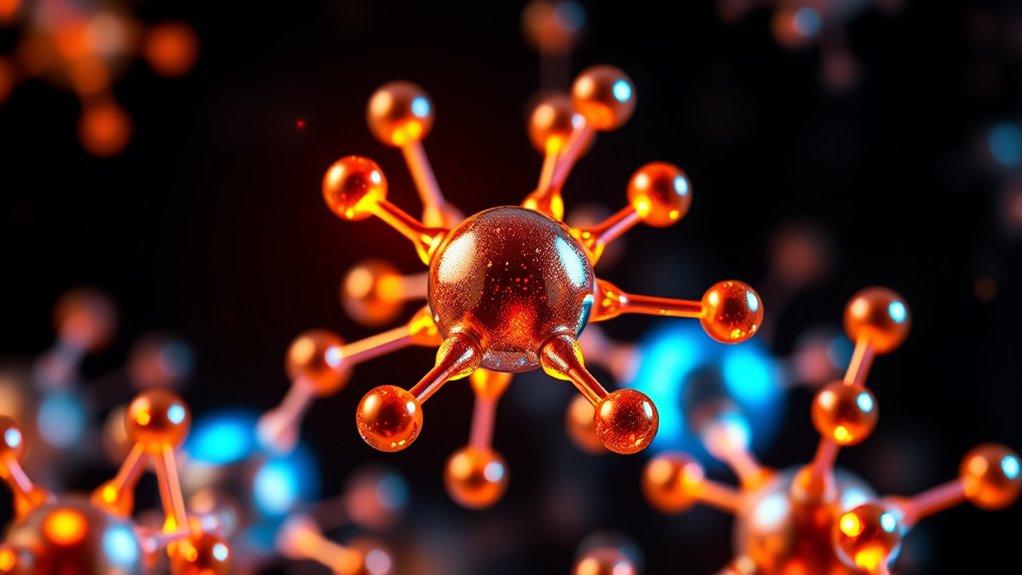
Non-covalent forces are essential electromagnetic interactions that enable molecules to associate without sharing electrons, shaping many biological and material systems. Ion-ion interactions are the strongest, occurring between oppositely charged ions like sodium and chloride, and are indispensable for stability in biological molecules.
Dipole-dipole interactions happen between polar molecules, influencing processes like protein-ligand binding. Van der Waals forces, including London dispersion forces, are the weakest but can become significant when many are combined, affecting properties of organic compounds like alkanes.
Hydrophobic effects drive nonpolar molecules to cluster in water, playing a crucial role in protein folding, membrane formation, and self-assembly. These forces collectively influence material properties, drug design, and biological functions, highlighting their broad importance beyond covalent bonding.
Additionally, electromagnetic interactions such as hydrogen bonds are vital for the structure and function of biological macromolecules like DNA and proteins, emphasizing the importance of non-covalent forces in life sciences.
How Bond Types Influence Material Properties
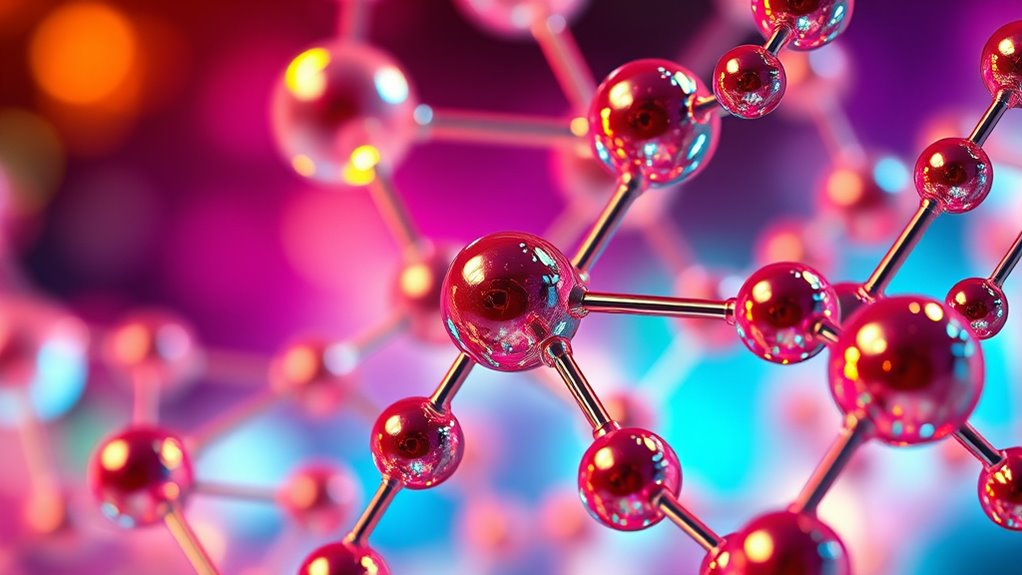
The types of chemical bonds that hold a material together directly influence its mechanical and thermal properties. If your material has high bond energy, it will be stronger and more durable, resisting wear and tear better. Layer textures through textiles, rugs, and cushions also affect the overall feel and aesthetic of the material. Ionic and covalent bonds tend to produce materials with high strength, like ceramics and polymers. The arrangement of atoms and bond nature also affects impact resistance and structural integrity, helping the material maintain its shape under stress. Thermally, strong ionic bonds lead to high melting points and stability, while covalent bonds in ceramics enhance heat resistance. Metals with metallic bonds conduct heat efficiently due to free electrons.
Real-World Examples of Chemical Bonding

Chemical bonds are everywhere in daily life, shaping the properties of the materials you encounter every day. Water’s covalent bonds between hydrogen and oxygen make it essential for life, while salt’s ionic bonds give it its salty taste and preservation traits.
Chemical bonds shape everyday materials, from water’s covalent bonds to salt’s ionic structure.
Molecular oxygen, with its nonpolar covalent bonds, is crucial for respiration. Household cleaners often contain covalent compounds that break down grime. In baking, ionic compounds like sodium bicarbonate release gases that cause dough to rise.
Industry relies on ionic bonds in electrolytes for conductivity and covalent bonds in pharmaceuticals for stability. Environmental processes depend on hydrogen bonds in water and covalent bonds in pollutants. Additionally, understanding chemical bonding helps in developing new materials with tailored properties.
In medicine, both bond types help build biological structures and develop drugs. These examples highlight how chemical bonding influences our daily routines and technological advances.
Frequently Asked Questions
How Do Ionic Bonds Form in Different Compounds?
Imagine you’re combining sodium and chlorine. You see sodium (a metal) loses an electron to become a positive ion, while chlorine (a non-metal) gains that electron, becoming negative. These opposite charges attract, forming an ionic bond.
You can expect similar processes in other compounds: metals lose electrons, non-metals gain them, and electrostatic forces hold the ions together, creating a stable ionic structure.
What Determines Whether a Bond Is Polar or Non-Polar?
You determine if a bond is polar or nonpolar by looking at the electronegativity difference between the two atoms. If the difference is less than 0.4, the bond is nonpolar; if it’s between 0.4 and 1.8, it’s polar. Keep in mind, molecular shape also matters—symmetrical molecules with polar bonds can be nonpolar overall, while asymmetrical ones are typically polar.
How Do Metallic Bonds Contribute to Electrical Conductivity?
Imagine a sea of free electrons flowing effortlessly through a metallic lattice like waves across the shore. These delocalized electrons carry electric charge, allowing you to conduct electricity smoothly.
When you apply a voltage, they drift toward the positive terminal, creating current. Thanks to this electron sea, metals remain excellent conductors, with their structure enabling quick, resistance-free electron movement that keeps your devices powered reliably.
Can Molecules Have Both Covalent and Ionic Bonds Simultaneously?
Yes, molecules can have both covalent and ionic bonds at the same time. You’ll often see this in compounds with polyatomic ions or salts, like sodium nitrate.
In these cases, ionic bonds connect the metal to the polyatomic ion, while covalent bonds hold atoms within the ion itself. This dual bonding creates compounds with unique stability and properties.
It blends the strengths of both bond types for diverse chemical behaviors.
Why Are Hydrogen Bonds Important in Biological Systems?
Hydrogen bonds are crucial in biological systems because they give water its unique properties, like high surface tension and solvent capabilities, which support life processes. They stabilize protein structures, ensuring proper folding and function.
Additionally, hydrogen bonds hold DNA strands together during replication and transcription, maintaining genetic stability. They also enable enzyme-substrate recognition and catalysis, making biochemical reactions efficient and precise.
Without hydrogen bonds, life’s molecular machinery couldn’t operate effectively.
Conclusion
So, next time you marvel at a diamond’s sparkle or wonder why water’s sticky, remember—it’s all about bonds. Ironically, these tiny attractions hold the world together, yet they’re often invisible and overlooked. Whether ionic, covalent, metallic, or hydrogen, each bond shapes your everyday life more than you realize. So, don’t take these chemical connections for granted—they’re the real building blocks behind everything, including your own existence.
